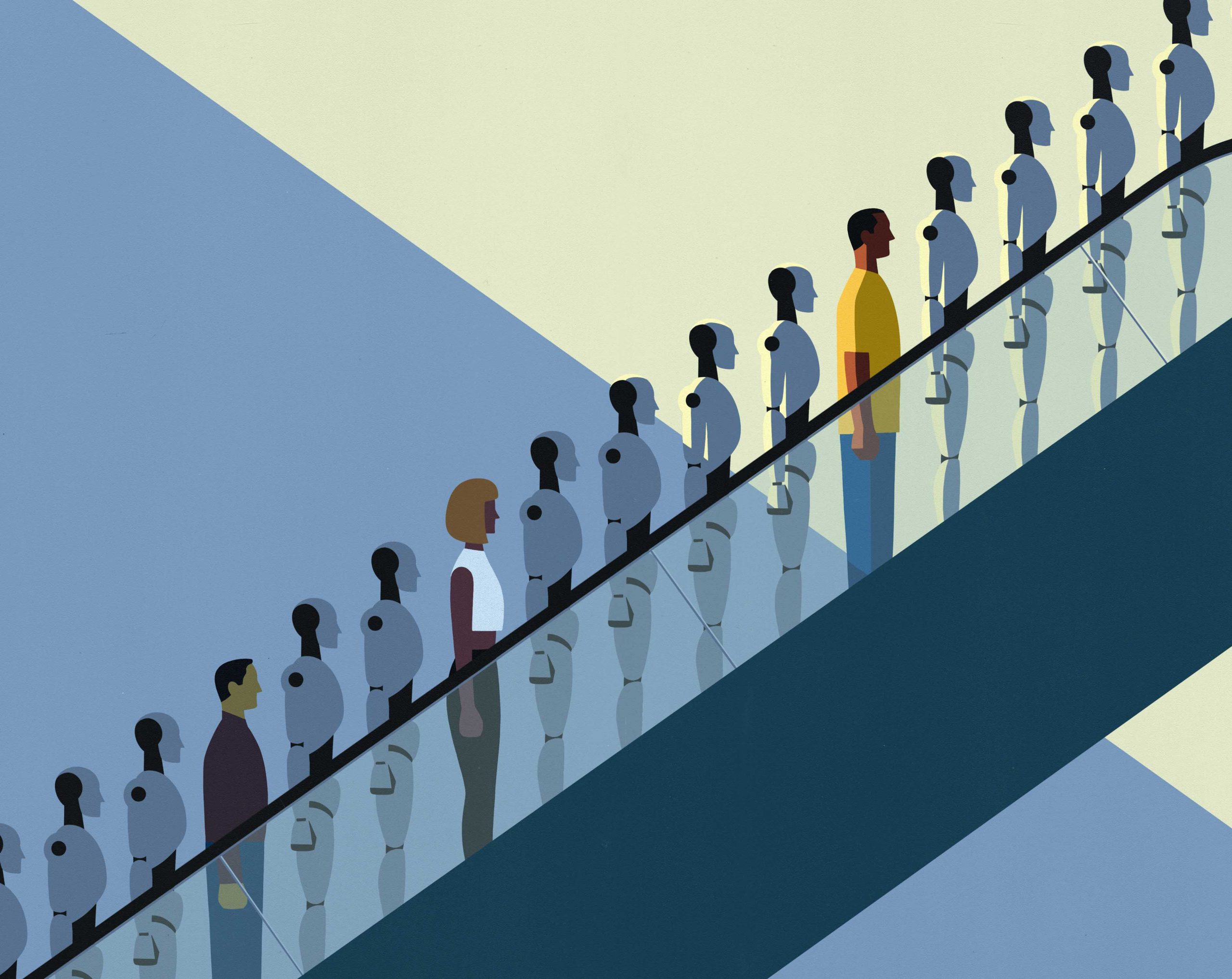Jon Krause
In the mid 20th century, British mathematician and computer pioneer Alan Turing explored the concept of intelligent machines. In 1947, he gave one of the earliest lectures on machine learning, laying the foundation for what would eventually be known as artificial intelligence (AI).
Today, AI is ubiquitous. We experience it in our daily lives through digital assistants, self-parking cars, ride-sharing apps and more. Algorithms, bots and smart devices are intertwined in our existence, but the human-machine relationship is not always symbiotic. With every great technological advancement comes inherent risks of abuse, over-reliance and, in some instances, redundancy.
As AI and machine learning continue to evolve, how will our shared existence evolve with them? From the workplace to the world stage, AI is expected to bring about unprecedented change to our daily lives. We spoke with faculty at Fox School with expertise across varying disciplines to get a sense of what we’re likely to see in the coming years.
Building trust in machines
Any task that involves solving problems based on large amounts of data or making predefined decisions can—and likely will—be automated. Even sophisticated tasks, typically performed by professional, salaried workers like lawyers or doctors, are primed for automation. An issue arises, however, when machines sometimes behave or make decisions in a way that humans can not understand.
For example, when Google’s DeepMind AlphaGo technology beat Lee Sedol, one of the top players in the game “Go,” observers noted that the system played the game with strategies never seen before. “If decisions made by AI are not understandable to humans it is difficult to trust such decisions and predict consequences,” says Min-Seok Pang, associate professor in the Department of Management Information Systems.
Pang believes that as machines become increasingly intelligent, humans will need to focus on understanding the rationale behind their decisions. He sees the Defense Advanced Research Projects Agency’s (DARPA) “Explainable AI (XAI),” a program designed to address those needs, as playing a crucial role in the future of machine learning. According to DARPA, the XAI program will create new machine learning techniques that produce more explainable models and enable humans to better understand and trust the upcoming generation of artificially intelligent partners.
“If our lives are going to be driven by AI, we have to be able to understand its rationale,” says Pang.
AI-powered workplaces
Leora Eisenstadt, assistant professor in the Department of Legal Studies, predicts an increase in AI usage in hiring for tasks like sorting through resumes and evaluating candidates. In the workplace itself it can aid in monitoring things like employee sentiment and workplace efficiency. This type of AI application in the workplace has its own benefits and detriments, and Eisenstadt sees both sides.
“On one hand, the use of AI in hiring represents an acknowledgment of the role that implicit bias plays in hiring and an effort by organizations to combat it,” says Eisenstadt. Additionally, utilizing AI to detect workplace harassment can help prevent bad actors and their contributions to toxic company culture. It can also help in improving job satisfaction by measuring and reporting employee sentiment.
Alternatively, this reliance on AI to drive the workplace forward poses a significant risk. “I am concerned that companies will turn to technology as a quick fix rather than doing the hard work of changing workplace culture on the ground,” says Eisenstadt. “There is a significant danger in relying on algorithms and believing they are better and less biased than humans.”
“The global pandemic will, of course, have massive, as yet undetermined, impacts on the workplace,” adds Eisenstadt. “The workplace that emerges after the pandemic will likely be changed by the large-scale migration to remote work and by the potentially smaller workforce. But the use of AI at work will continue to bring benefits and problems as employers navigate back from the economic crisis caused by COVID-19.”
An emerging global innovation leader
Bertrand Guillotin of the Department of Strategic Management looks toward the future with a global perspective. “China has decided to become the AI leader of the world,” says Guillotin. “And I think they will be.”
According to Guillotin, China has the brainpower and capabilities to advance AI research. A recent analysis by the Allen Institute for Artificial Intelligence shows that China has already surpassed the U.S. in published AI research papers and, if current trends continue, is positioned to overtake the U.S. in the top 1% of most-cited papers by 2025.
Additionally, their hybrid of socialism with infused market capitalism gives them the flexibility and security to make strategic decisions that drive innovation forward. Even as we compete for the leading position, the U.S. and China are more interdependent than ever, to fight COVID-19 and address global economic growth, in general. This interdependence, however, can be a cause for concern. “I am worried about the pandemic-related economic downturn in China,” says Guillotin, “which could exacerbate social tensions and potentially sideline the country’s prioritization of AI and global leadership.”
Despite his concerns, Guillotin remains optimistic about the future of AI. He believes that if China wins the AI race, they will become de facto leaders in many key growth industries, which would positively contribute to the global economy and help it to become more resilient. This is reminiscent of what happened with Japan and its rise in the top 10 economic powers decades ago.
AI & the Future of Work
It may come as a surprise that not all professional, white-collar jobs are immune to automation. As AI advances and workplaces look to become more efficient, any simple or routine tasks will be at risk. According to Min-Seok Pang, this will shift job responsibilities and roles to become more complex and strategic. In the Fox School’s Expert Series on IGTV, Pang discusses the impact of AI and machine learning on the future job market and explains how to navigate the changing landscape.

